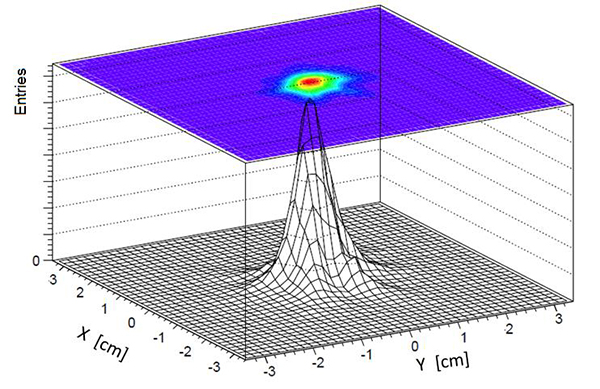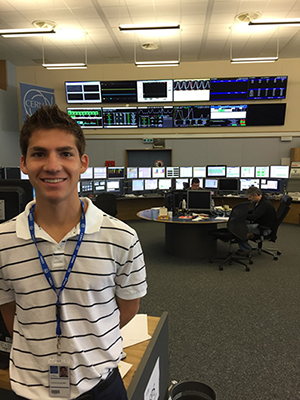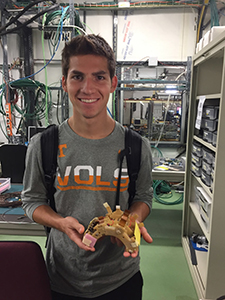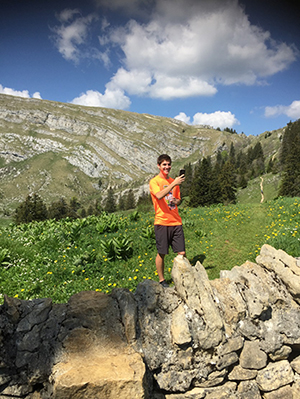Crash Course in Collisions
Contributed by Professor Stefan Spanier
May 22, 2017. It was one day before the Large Hadron Collider (LHC) at the international particle physics laboratory CERN in Geneva, Switzerland, was scheduled to start up again. Physics undergraduate Nick Brey had left Knoxville the day before to join the UT team helping commission a detector that’s part of a larger collection of instruments placed deep underground, where beams of protons collide. The UT group collaborates with researchers to use the so-called Compact Muon Solenoid (CMS) detector to search for new particles that result from those proton collisions at unprecedented high energies. They also discover more and more details about the Higgs particle that has been observed with this and its sister instrument, ATLAS, in 2012.
After a long winter break with upgrades and repairs to accelerators and detectors, and just in time for UT’s summer break, the first protons to circulate in the LHC were expected the next day. The detector Nick wanted to help with is actually the smallest among the CMS assembly, and is located right next to the beam pipe. It measures the positions of charged particles in three closely spaced detector layers during each collision of the protons. The viewing angle of those three layers is toward the point where collisions take place. It very rapidly (within 25 nanoseconds), counts the number of such tracks. And it does that from the very first moment there is any proton beam in the accelerator, even if it is filled only to a small fraction, as it gives continuous feedback of the beam conditions to the LHC control and to the CMS experiment. This helps obtain the best beam steering possible. Furthermore, it helps to optimize the amount of effective proton collisions. The quantity that measures this is also called the luminosity of the accelerator. The instrument translates the rate of charged particle tracks into this luminosity. Hence, it is also called the luminosity telescope. The precision at which the luminosity is known directly defines the precision of all particle production measurements. Hence, this smallest instrument plays actually one of the most important roles, and it has to work reliably and precisely for the whole data taking period.
Nick’s job was to inspect the very first tracks measured with the luminosity telescope and use them to align the three planes with respect to each other to view the collision point. There are actually 16 separate telescopes, each with three detector layers, and all have to be carefully aligned. The detectors are fixed in place deep inside the CMS detector and cannot be touched. But one can use the straight tracks of charged particles to find out how much their center positions are shifted with respect to each other, assuming the hits on those planes should line up behind each other. This is done with computer programs that vary the measured positions by some offsets to find the optimum values for those offsets. Before relying on those track measurements, Nick had to carefully inspect the quality of the signals that those detectors produce when a charged particle hits—and there are about 1000 individual readout channels or pixels per detector plane. This amounts to a lot of information. But this quality monitoring can be done with computer programs that turn raw signal measurements into colorful charts. Nick quickly learned how to judge inefficient pixels and was able to run calibrations to change and improve the characteristics of such channels. Within a few days the detector was in such good shape that in addition to the luminosity measurement, Nick could present a spatial measurement of the spot where beams collide to impressed CMS researchers. His beam spot distribution was used as public performance plot (below).


Nick also had the opportunity to visit the LHC main control room, which is actually over the border in France. There the online luminosity measurement from the CMS telescopes is displayed on a monitor to aid the tuning of the LHC beam. Nick also visited the laboratory within CERN where the next version of the luminosity telescope is already prepared. The present one is expected to become too inefficient to continue after 2018 due to radiation damage. The enormous amount of particles that are created in those proton collisions presents actually a radiation hazard to the instruments, particularly if they are as closely placed to the beam as the telescopes.
Nick then participated in data taking with the CMS detector in the experiment control room and the daily briefing meeting where experts from the different sub-systems of CMS present and discuss problems and plan for the coming day. This can be as critical as the observation of a water leak at a corner of the detector that needs an emergency intervention, as happened while Nick sat in. These are teething problems that can occur during such a startup phase. After this intense startup Nick was able to explore the Swiss mountains and enjoy lunch high above Lake Geneva and relax later that day at the Bains de Paquis, the public beach right in the middle of Geneva. The luminosity telescope is since running very successfully and continuously publishing the luminosity measurement. Nick returned to Knoxville and has continued analyzing data taken since then, learning more about the physics conducted with CMS at LHC. All in all, a crash course in collisions.

Nick in the laboratory at CERN holding the upper half of the frame that holds four of the luminosity telescope planes. This frame sits on top of the beamline, a second one below to complete full azimuthal coverage on one side of the collision point. A set of such two frames with 8 telescopes is also placed on the opposite side of the collision point.

Nick in the Swiss mountains.